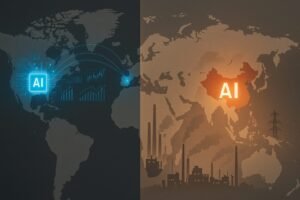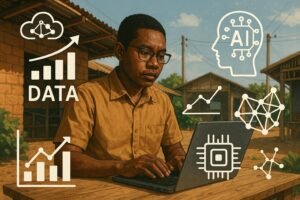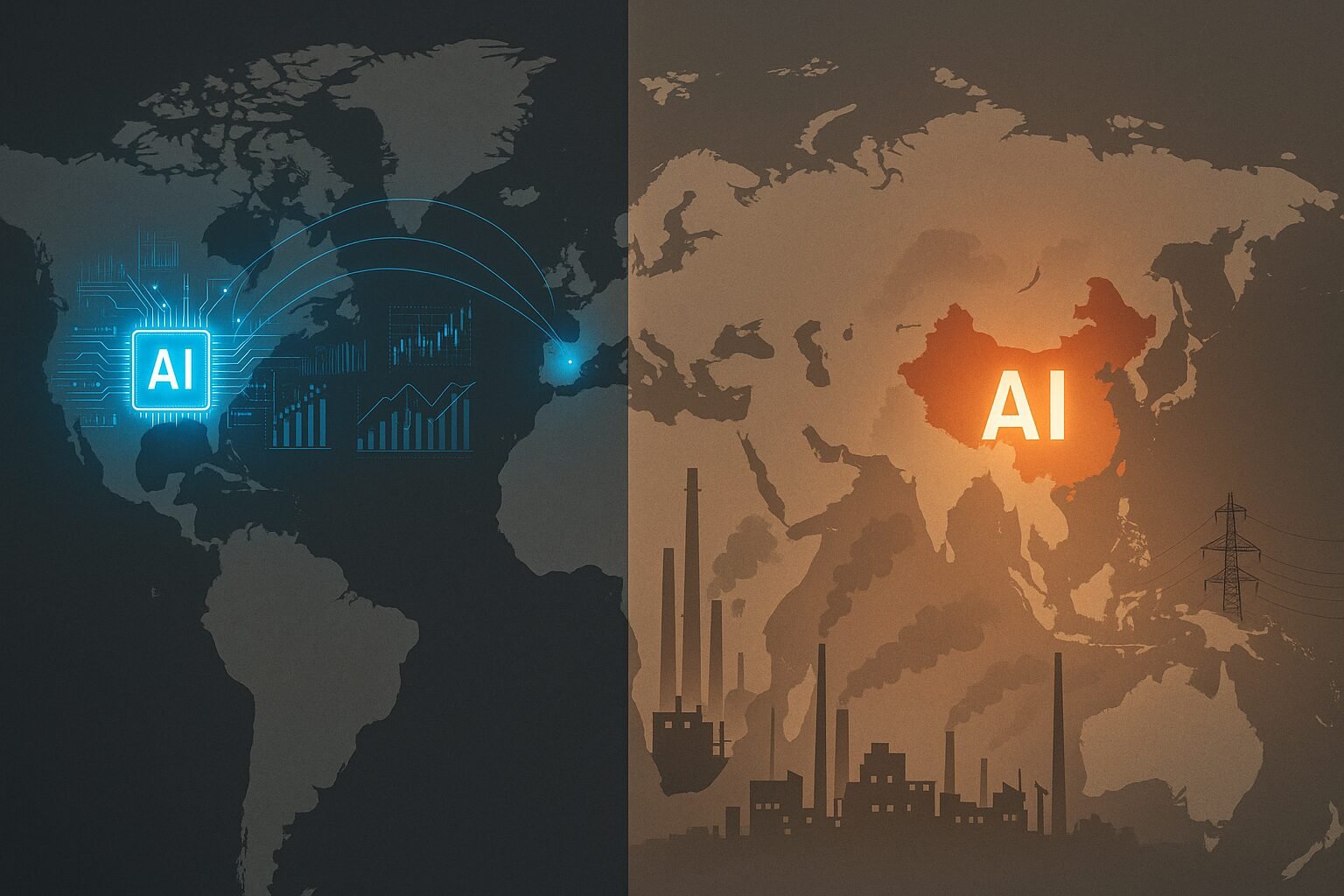AI – West vs the Rest: Bridging the Global Divide in Artificial Intelligence
By Sudhir Tiku
Fellow AAIH & Editor AAIH Insights

The contents presented here are based on information provided by the authors and are intended for general informational purposes only. AAIH does not guarantee the accuracy, completeness, or reliability of the information. Views and opinions expressed are those of the authors and do not necessarily reflect our position or opinions. AAIH assumes no responsibility or liability for any errors or omissions in the content.
AI Is Not a Global Phenomenon
Artificial Intelligence, hailed as the most transformative technology of our time, is often framed as a global revolution. The narrative suggests that AI is reshaping every industry, augmenting human productivity and accelerating progress worldwide. But peel back this glossy veneer and the reality is far more uneven. AI is not truly global; it is overwhelmingly lopsided.
The development and deployment of AI is concentrated in a handful of countries, primarily the United States, few countries of Europe and now China. Meanwhile, vast regions of the world, particularly in Africa, Southeast Asia, Latin America, and parts of the Middle East remain on the margins of this transformation. The reasons are complex, but they boil down to disparities in compute, data access, infrastructure, talent, and geopolitical power. To ensure AI benefits all of humanity, we must recognize these imbalances and design targeted strategies to address them.
I. The Compute Divide: Unequal Infrastructure, Unequal Opportunity
AI systems, especially state-of-the-art large language models require massive computational resources. Training a frontier model can cost tens or even hundreds of millions of dollars. These systems rely on clusters of thousands of GPUs, often housed in climate-controlled and liquid cooled data centers. Unsurprisingly such infrastructure is scarce outside the U.S., China, and a few parts of Europe.
Example:
- In 2023, the U.S. accounted for nearly 60% of the world’s high-end AI compute capacity. NVIDIA’s A100 and H100 GPUs were mostly snapped up by American tech giants or Chinese titans. Of course they have the first mover’s advantage.
- Africa, by contrast, had less than 1% of global AI compute capacity. Most researchers in the region rely on cloud credits, often granted sparingly through academic programs or competitions.
This creates a self-perpetuating loop: if you can’t train large models, you can’t participate in advancing the field; if you can’t advance the field, you don’t attract funding or talent.
II. Data Colonialism: Whose Data Trains the Models?
AI thrives on data. The larger and more diverse the dataset, the better the model. But here, too, we see stark asymmetries. Most large language models are trained on data scraped from the internet which is English language dominant and has Western-centric platform and similar news archives.
Consequences:
- Language exclusion: Less than 1% of AI training data comes from African or Southeast Asian languages, though these languages are spoken by billions. As a result, models struggle with Swahili, Tamil, Lao, or even major regional variants of Arabic.
- Cultural erasure: Non-Western ways of thinking, storytelling, or problem-solving are underrepresented. If your cultural knowledge doesn’t exist in an English language or any Wikipedia article. it might as well not exist to an AI model.
The irony is striking: Global South data like social media posts, mobile metadata, consumer behavior is often harvested by Western platforms, but the benefits of this data accrue elsewhere.

III. The Talent Bottleneck: Education, Access, and Brain Drain
While talent is universally distributed, opportunity is not. The global AI research community is dominated by a few elite institutions of the West. These serve as gateways to careers at leading AI labs.
Data point:
- In NeurIPS 2023, only 3% of accepted papers came from institutions in the Global South.
- Fewer than 1% of major AI researchers come from sub-Saharan Africa or smaller Asian nations outside China, India, or Singapore.
Barriers include lack of access to GPU resources, limited mentorship opportunities, and poor internet connectivity in many countries. Even when talented individuals emerge, they are often snapped up by Western firms which is a classic case of brain drain.
Solutions:
How can we prevent AI from becoming yet another axis of global inequality? How do we democratize access to this epoch-shaping technology?
1. Open Models, Open Data, Open Infrastructure
One of the most effective ways to level the playing field is through open-access AI resources.
- Open models like LLaMA allow researchers from under-resourced regions to fine-tune and deploy powerful AI without starting from scratch.
- Open datasets in local languages, histories, and cultural contexts can help decolonize AI knowledge. Projects like Masakhane (for African NLP) and BLOOM (a multilingual open model) are promising starts.
- Open-source infrastructure tools like Hugging Face’s Transformers and collaborative platforms like Papers with Code lower the barrier to entry.
2. Regional AI Compute Hubs and Cloud Subsidies
We need public investment to create regional compute centers akin to how the world-built universities or public libraries in the past century.
- Africa’s AI Research Cloud, being piloted in Rwanda and Kenya is a promising example, aiming to give regional researchers GPU access.
- International organizations like the UN, World Bank or AI for Good can coordinate grants and subsidized cloud credits for researchers and startups in underrepresented regions.
3. Educational Pipelines and Local Mentorship
You can’t build local AI ecosystems without education. But MOOCs alone are not enough. We need:
- Localized AI curriculums that include local languages and datasets.
- Mentorship programs pairing experienced researchers with local talent (e.g., the Deep Learning Indaba).
- Regional fellowships to fund PhDs, conferences, and summer schools in Global South countries.
Think of it as a Marshall Plan for AI education.
4. AI Regulation to Prevent Data Colonialism
Governments in the Global South should proactively regulate how their citizens’ data is collected, exported, and monetized. Without this, tech giants will continue to mine these regions for data while returning little in value.
- Introduce data sovereignty laws, ensuring that local data is stored and processed within national boundaries.
- Mandate revenue sharing if AI models trained on local data are monetized.
- Require algorithmic transparency when foreign AI systems are deployed domestically, especially in critical areas like finance, healthcare, or criminal justice.
5. Support for Local AI Startups and Innovation
Local problems require local solutions. AI can solve critical challenges in agriculture, healthcare, transportation, and governance—but only if developed in context.
- Create sovereign AI innovation funds, backed by governments or public-private partnerships.
- Incubate local AI startups through tax incentives, regulatory sandboxes, and access to public data.
- Promote cross-border collaboration between countries facing similar challenges (e.g., African Union AI consortiums).
VI. The Stakes: Why This Matters
AI is not just another wave of automation. It is a general-purpose technology—like electricity, printing, or the internet—that will rewire society. If we fail to make it inclusive, we risk deepening the already yawning gaps in wealth, power, and voice.
We risk:
- AI systems that can’t understand or serve most of the world’s population.
- Decision-making algorithms that ignore or misrepresent non-Western values.
- Global power further concentrated in a handful of companies and countries.
We talk often about AI safety, but inclusivity is safety. Diversity in data, talent, and perspective is a form of robustness. An AI shaped by the whole world is less likely to replicate its worst instincts.
Conclusion: Decentralizing the Future
AI is often compared to fire, a tool that can warm homes or burn them down. But that analogy misses something crucial: fire spreads. AI doesn’t, unless we intentionally distribute its benefits.
The dream is to build a world where:
● A researcher in Nairobi can train a state-of-the-art model on African data using local compute.
● A student in Phnom Penh can build an AI startup solving rural education with models in Khmer.
● A government in Bogotá can audit imported AI systems and build their own.
The future of AI should not be written in just a few languages or powered by just a few data centers. It must be co-authored by all of us.
Only then can we say that AI is truly global.

